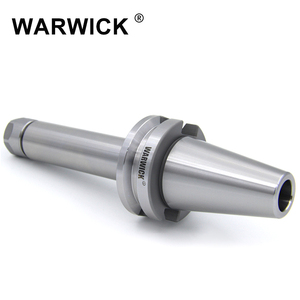(1023 products available)

































































































































































































Collet arbor refers to the tool holder that connects the machine's spindle to the cutting tool. Usually, it comes in two main types, including the taper and straight types.
Tapered collet arbors
Tapered collet arbors are usually designed to fit certain tapers, such as R8 or CAT tapers. The taper collet arbors have a wedge-shaped profile, getting wider towards the base. This design helps create a secure and precise fit when rotating, which can hold the tools well.
Straight collet arbors
Straight collet arbors have a cylindrical shape with a consistent diameter. They are compatible with various collets, which are clamp-like tools or instrument holders that secure the cutting tools.
Aside from the two main types, there are also some popular variations of collet arbors.
Threaded collet arbor
Usually, the threaded collet arbor has external threads that can connect directly to the workpiece or spindle. This design allows for easy installation, removal, and adjustment. It is commonly used in lathes, mills, and machining centers.
R8 collet arbor
The R8 collet arbor is a commonly used tool holder in various milling machines and lathes. It offers a good grip for cutting tools with different shank sizes. Its adaptability makes it suitable for many machining and manufacturing processes.
MT collet arbor
The MT collet arbor is a tool holder that utilizes Morse tapers for tool attachment. Its design offers precise alignment and reliable clamping force during operation, making it suitable for high-precision machining applications.
Collet arbors are machinists' preferred work-holding devices for various machining tasks such as routing, drilling, holding taps, and end mills. In most cases, collet arbors are used to fix cutting tools in a precise position on a workpiece when rotating.
Some of the commonly used collet arbors in CNC machining include:
Aside from CNC machining projects that require high-precision taps and cuts, collet arbors are also widely used in the following industries:
Here are some tips for choosing the right collet arbors for business use.
Machine Compatibility
Ensure that the collet arbor will fit the machines in the workshop. Check the spindle sizes to match the collet arbor. Also, make sure that the collet itself will work with the existing equipment.
Material
Choose a collet arbor made from quality steel. An industry-standard like alloy steel or carbon steel will perform well for many tasks. Such materials offer good rigidity and precision. They can handle high rotational speeds without bending or vibrating off-center.
Variety of Sizes
Consider the supplier who offers a wide range of collet arbors. Though the customers may prefer one type more, it's good to have options. Choose different styles like straight collet arbor or tapered ones for varied functions. Some may be better with more specific machines.
Affordability
It's essential to buy collet arbors that provide good value for the budget spent. Compare the prices and quality of the products from different suppliers. Buying in bulk may offer better value so consider the collet sizes to get more.
Delivering and After-Sales Support
Make sure the supplier can deliver the order on time. Good delivery tracking will help know where the products are during shipping. It's also important to find a supplier that offers excellent after-sales support.
Q1: What is the difference between a collet and an arbor?
A1: A collet is a clamping device used to hold cylindrical objects, including drill bits, tightly and securely, while an arbor is a spindle or shaft designed to support or hold a tool, such as a saw blade.
Q2: What are some benefits of using a collet chucks?
A2: Collet chucks offer several advantages, including easy loading and unloading of workpieces, uniform clamping force for consistent machining results, compact size for minimal concentricity loss, and self-centering capabilities for accurate alignment.
Q3: What are the most common types of collets?
A3: Some of the most popular types of collets are the end collet, the step collet, the hex collet, the anti-flex collet, and the rubber collet.
Q4: How should collets be stored when not in use?
A4: When not in use, collets should be stored in a dry and clean place, preferably in a collet rack or cabinet. This makes it easy to find them later on. Be sure to separate them so that their clamping surfaces don't get damaged.